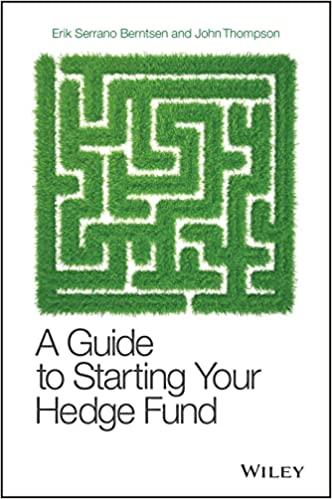Question
1, Lee is considering buying one of two newly-issued bonds. Bond A is a twenty-year, 7.5% coupon bond that is non -callable. Bond B is
1, Lee is considering buying one of two newly-issued bonds. Bond A is a twenty-year, 7.5% coupon bond that is non -callable. Bond B is a twenty year, 8.25% bond that is callable after two years. Both bonds are comparable in all other aspects. Lee plans on holding his bond to maturity. What should Lee do if he feels that interest rates are going to decline by 2% in the near future and then remain relatively stable thereafter?
A) purchase Bond A
B) negotiate a higher rate on Bond A
C) purchase neither A nor B at this time
D) purchase Bond B
2, One of the most popular tools of technical analysis is
A) financial statement analysis.
B) investor behavior analysis.
C) investor profiling.
D) charting.
3, In a severe recession, the major source of risk faced by investors who purchase corporate bonds is
A) purchasing power risk. B) default risk.
C) liquidity risk. D) interest rate risk.
4) Lee is considering buying one of two newly-issued bonds. Bond A is a twenty-year, 7.5% coupon
bond that is non - callable. Bond B is a twenty year, 8.25% bond that is callable after two years. Both
bonds are comparable in all other aspects. Lee plans on holding his bond to maturity. What should
Lee do if he feels that interest rates are going to decline by 2% in the near future and then remain
relatively stable thereafter?
A) purchase Bond A B) negotiate a higher rate on Bond A
C) purchase neither A nor B at this time D) purchase Bond B
TRUE/FALSE. Write 'T' if the statement is true and 'F' if the statement is false.
5) The coupon rate on convertible bonds is usually higher than the coupon rate on equivalent bonds
that are not convertible.
MULTIPLE CHOICE. Choose the one alternative that best completes the statement or answers the question.
6) The expectations hypothesis states that investors
A) require the real rate of return to rise in direct proportion to the length of time to maturity.
B) require higher long-term interest rates today if they expect higher inflation rates in the future.
C) expect higher long-term interest rates because of the lack of liquidity for long-term bonds.
D) normally expect the yield curve to be downsloping.
7) The liquidity preference theory supports ________ yield curves.
A) flat B) upsloping C) humped D) downsloping
8) What is the current price of a 9%, $1,000 annual coupon bond that has eighteen years to maturity
and a yield to maturity of 9.631%?
A) $942 B) $935 C) $947 D) $898
9) As applied to bonds, duration refers to
A) the average price and annual reinvestment rate of return for a bond.
B) the point in the life of a bond when its price exactly offsets its reinvestment risk.
C) the average maturity of a diversified portfolio of corporate bonds.
D) the point in the life of a bond when its yield-to-maturity equals its expected yield.
10) A portfolio consists of three bonds as follows. 21)
Amount Invested Bond Duration
Bond X $5,000 8.6 years
Bond Y $4,000 4.2 years
Bond Z $1,000 11.4 years
What is the duration of the bond portfolio?
A) 8.69 years B) 8.07 years C) 11.4 years D) 7.12 years
11) A bond has a YTM of 6.5%, a modified duration of 16.9 years, a duration of 18 years and a 30 year 22)
maturity. By what percentage will the bond's price change if market interest rates increase by
0.75%?
A) +12.675 percent B) -0.750 percent C) +0.750 percent D) -12.675 percent
12) What is the average annual compound rate of return for a fund with the following values?
Fund price, beginning of year 1 $19.32
Fund price, end of year 3 $21.22
Annual distribution, year 1 $1.34
Annual distribution, year 2 $1.86
Annual distribution, year 3 $1.14
A) 32.3% B) 10.8% C) 25.6% D) 10.5%
13) On January 1, Stacy's portfolio was valued at $96,534. During the year Stacy received $3,285 in
interest and $4,100 in dividends. She also sold one stock at a gain of $850. The value of the portfolio
on December 31 of the same year was $113,201. At the end of June, Stacy withdrew $5,000 from the
portfolio. What is the holding period return for the year?
A) 25.1% B) 27.2% C) 26.5% D) 25.8%
14) Allison's portfolio has an expected return of 14% and a beta of 1.37. Brianna's portfolio has an
expected rate of return of 11% and a beta of 1. The risk-free rate is 3% and the expected rate of
return on the market is 12%. According to the Jensen's measure,
A) The answer depends on Allsison and Brianna's risk tolerance
B) The portfolio's are equally desirable
C) Brianna has the better portfolio
D) Allison has the better portfolio
15) The general theory of dollar cost averaging is
A) to sell as markets decline and buy as they begin to rise.
B) to time the market to take advantage of low stock prices.
C) to equal the performance of market averages at the lowest dollar cost.
D) to buy more stock when prices are low and less when prices are high.
3
Step by Step Solution
There are 3 Steps involved in it
Step: 1

Get Instant Access to Expert-Tailored Solutions
See step-by-step solutions with expert insights and AI powered tools for academic success
Step: 2

Step: 3

Ace Your Homework with AI
Get the answers you need in no time with our AI-driven, step-by-step assistance
Get Started


